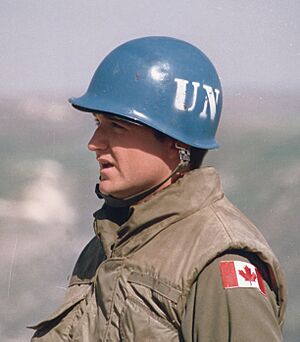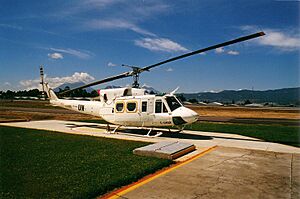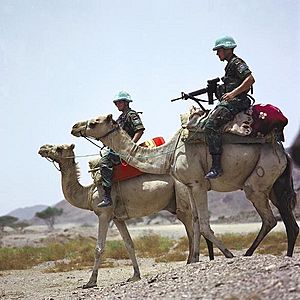History of United Nations peacekeeping facts for kids
The United Nations Peacekeeping efforts started in 1948. Their very first job was in the Middle East. They went there to watch and help keep the ceasefire (a stop to fighting) during the 1948 Arab–Israeli War. Since then, UN peacekeepers have been part of 72 missions all over the world. Twelve of these missions are still going on today. The entire peacekeeping force won the Nobel Peace Prize in 1988 for their important work.
Even though the word "peacekeeping" isn't directly in the United Nations Charter (the UN's rulebook), the power to do it comes from its rules. These rules allow the UN Security Council to investigate problems and help solve arguments. They can also approve actions like stopping trade or even using military force to end conflicts. The people who created the UN hoped it would stop wars between countries. But the start of the Cold War made peacekeeping very hard. The world was split into two big, unfriendly groups. After the Cold War ended, many people wanted the UN to work even harder for world peace. Because of this, peacekeeping missions grew a lot. More missions were approved between 1991 and 1994 than in the previous 45 years combined!
Contents
How UN Peacekeeping Started
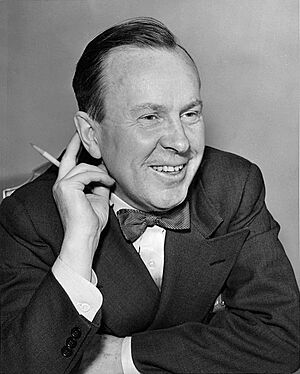
Before the UN officially started peacekeeping, other groups tried similar things. For example, the League of Nations (an earlier international group) had a force in the Saar region from 1934 to 1935. This might have been the first real international group to watch for peace.
The UN also helped with a problem in Trieste after World War II. From 1947 to 1954, Trieste was a special independent city under UN protection. It was divided into two areas, which later became part of Italy and Yugoslavia. The UN allowed the US and UK to have troops in one zone and Yugoslavia in the other.
The first official UN peacekeeping mission began in 1948. A team of observers went to the Middle East during the 1948 Arab–Israeli War. This mission was approved on May 29, 1948. This date is now remembered as the International Day of United Nations Peacekeepers. It honors all the peacekeepers who have died. This group, called the UN Truce Supervision Organization (UNTSO), still watches the situation today. They have helped in many conflicts in the region since then.
In 1949, observers were sent to the border of India and Pakistan. This was after the Indo-Pakistani War of 1947 (UNMOGIP). They also continue to watch that border. In 1950, the UN faced a huge challenge when North Korea invaded South Korea, starting the Korean War. The Soviet Union was not taking part in the UN at the time. They were protesting because Republic of China (Taiwan) held China's seat, not the People's Republic of China (mainland China). Because of this, the Soviet Union could not stop the UN from allowing member countries to help South Korea. UN forces pushed North Koreans back. They reached the Chinese border before China sent its own army. This pushed the UN forces back to the 38th parallel. A ceasefire was declared in 1953. UN forces stayed along the demilitarized zone until 1967. Then, American and South Korean forces took over.
In 1956, the UN responded to the Suez Crisis. They sent the United Nations Emergency Force (UNEF) to make sure invading forces left the area. A Canadian diplomat named Lester Pearson first suggested the idea of UNEF. He later became Canada's Prime Minister. He thought that unarmed or lightly armed soldiers from different countries could help solve problems. These soldiers would work under UN command. They would go to areas where fighting groups needed a neutral party to watch the peace process. Pearson's idea was seen as very smart. He even offered 1,000 Canadian peacekeepers for the cause. Pearson won the Nobel Peace Prize in 1957 for creating UN peacekeeping operations. UNEF was the first armed peacekeeping mission based on his ideas. Since 1956, most UN peacekeeping forces, even "observer" missions, have carried weapons.
Peacekeeping During the Cold War
Throughout the Cold War, the UN Security Council often had trouble agreeing. This made it hard to start peacekeeping missions in countries where the conflict was linked to the spread of communism or other political movements. Some conflicts were far enough from the Cold War that peacekeeping missions got support. But most were too deeply connected to the global struggle between the two superpowers.
Conflicts Around the World
The UN Peacekeeping Force in Cyprus started in 1964. It tried to end the fighting between Greek and Turkish people on the island. It also aimed to prevent a bigger conflict between NATO members Turkey and Greece. Another observer force, UNIPOM, was sent in 1965. This was to areas of the India-Pakistan border not watched by the earlier UNMOGIP mission. This happened after a ceasefire in the Indo-Pakistani War of 1965. Neither of these conflicts were seen as having Cold War connections.
There was one unusual case. In the Dominican Republic (DOMREP), from 1965 to 1966, the UN approved an observer mission. This was in a country where different political groups were fighting. However, the mission only started after the US had already stepped in during a civil war. The US had taken control and invited a force from the Organization of American States (mostly US troops) to keep the peace. The UN mission was approved mainly because the Americans had already acted. Also, the UN mission was not a full peacekeeping force. It only had two observers at any time. It left the main peacekeeping to another international group. This was the first time the UN worked with a regional group in this way.
Helping Countries Become Independent
The UN also helped with two decolonization programs during the Cold War. Decolonization means when a colony becomes an independent country. In 1960, the UN sent ONUC to help the Congo become independent from Belgium. It stayed until 1964 to help keep the country stable during the Congo Crisis. In West New Guinea, from 1962 to 1963, UNSF kept law and order. This was while the area was transferred from Dutch control to Indonesia.
Middle East Conflicts
The Middle East was a very active place for UN peacekeeping during the Cold War. The fighting groups there were usually not strongly linked to the superpowers. The superpowers mainly wanted stability in this important oil-producing region. In 1958, UNOGIL was approved. Its job was to make sure no illegal people or weapons crossed the Lebanese borders. A few years later, the Yemen Observer Mission (UNYOM) started in 1963. It tried to end the civil war in Yemen. This war had sides supported by regional rivals Egypt and Saudi Arabia.
Throughout the 1970s, the UN also approved several peacekeeping missions to try and calm the Arab–Israeli conflict. These included missions in Suez (UNEF II) in 1973 and in the Golan Heights (UNDOF) in 1974 after the Yom Kippur War. Another mission was in Lebanon (UNIFIL) in 1978 after the 1978 South Lebanon conflict. In the 1980s, only one new mission was approved in the region. This was UNIIMOG. It supervised the withdrawal of troops to the border between Iraq and Iran after almost eight years of war.
After the Cold War
When the Soviet Union became weaker, it greatly reduced its military and money support for many "proxy" civil wars around the world. Proxy wars are conflicts where bigger powers support opposing sides without directly fighting each other. The Soviet Union also stopped supporting its satellite states (countries under its influence). One UN peacekeeping mission, UNGOMAP, was created to watch the Pakistan–Afghanistan border. It also oversaw the withdrawal of Soviet troops from Afghanistan. In 1991, the Soviet Union broke apart into 15 independent countries. Conflicts started in two former Soviet Republics: the Georgian–Abkhazian conflict in Georgia and a civil war in Tajikistan. These were eventually policed by UN peacekeeping forces, UNOMIG and UNMOT.
With the end of the Cold War, many countries asked the UN to do more for world peace. They wanted the UN to help end conflicts everywhere. The Security Council could now agree more easily. This led to a big increase in peacekeeping missions. In a new spirit of cooperation, the Security Council started larger and more complex UN peacekeeping missions. Also, peacekeeping began to include more non-military tasks. These tasks made sure that everyday things worked properly, like elections. The UN Department of Peacekeeping Operations was created in 1992 to handle the growing need for these missions.
Many missions were designed to end civil wars where opposing sides had been supported by Cold War players. In Angola (UNAVEM I, II, and III), missions aimed to end fighting between the rebel group UNITA and the ruling MPLA. ONUMOZ was similar. It oversaw the end of conflict between RENAMO and the government in Mozambique, ending the Mozambican Civil War. In Cambodia, UNAMIC and then UNTAC took control of the entire country for the UN. They organized and ran an election before giving control to the new government.
In Central America, ONUCA watched to make sure no country helped rebel groups in another. Five nations were involved: El Salvador, Guatemala, Costa Rica, Nicaragua, and Honduras. The rebel groups in all five countries, whether communist or anti-communist, agreed to peace deals helped by the UN in the 1990s. In El Salvador, another UN peacekeeping force, (ONUSAL), checked the ceasefire between the socialist FMLN and the government. Similarly, in Guatemala, MINUGUA was approved in 1996 to check the ceasefire between the leftist URNG and the government.
Modern Peacekeeping Efforts
International Conflicts Today
In 1991, the political changes after the Soviet Union's collapse allowed the first approved operation of collective self-defense since the Korean War. This was to push Iraq out of Kuwait in the Gulf War. After the fighting stopped, the UN approved the United Nations Iraq–Kuwait Observation Mission (UNIKOM). Its job was to watch the demilitarized zone (DMZ) between the two countries. Two other conflicts between countries have led to UN peacekeeping since then. In 1994, the United Nations Aouzou Strip Observer Group (UNASOG) watched as Libya left a disputed area. This was according to a decision by the International Court of Justice. In 2000, UN Mission in Ethiopia and Eritrea (UNMEE) was set up. It monitored the end of fighting after the Eritrean–Ethiopian War.
Civil Wars Around the World
The 1990s also saw the UN focus on preventing genocide (the killing of a large group of people from a specific ethnic group or nation) and ethnic cleansing (forcing people from a specific ethnic group out of an area). The Civil War in Rwanda and the breakup of Yugoslavia both involved widespread terrible acts and violence between ethnic groups. Eight UN peacekeeping missions have been sent to the former Yugoslavia: UNPROFOR, UNCRO, UNPREDEP, UNMIBH, UNTAES, UNMOP, UNPSG, and UNMIK. Two missions went to Rwanda: UNAMIR and UNOMUR.

Even though international aid linked to the Cold War ended, civil wars continued in many regions. The UN tried to bring peace. Several conflicts led to multiple peacekeeping missions.
The collapse of Somalia into the Somali Civil War in 1991 saw UNOSOM I, UNITAF, and UNOSOM II try to bring peace and stability. While they didn't fully succeed, they did help reduce the effects of famine.
The First Liberian Civil War led to the approval of UNOMIL in September 1993. It helped and supervised troops from the Economic Community of West African States (ECOWAS). ECOWAS had stepped in to help the Liberian government. UNOMIL also oversaw the peace agreement. However, two rebel groups started the Second Liberian Civil War in 2003. Then, UNMIL was sent to oversee the ceasefire agreement. It continues to help with national security reform.
A coup (a sudden, illegal takeover of government) in Haiti in 1991, followed by violence, led to the UN Mission in Haiti (UNMIH). In 1996 and 1997, three missions (UNSMIH, UNTMIH, and MIPONUH) were organized. Their goal was to reform, train, and help the police during a time of political trouble. A coup in 2004 removed the president. The UN then approved MINUSTAH to stabilize the country.
In Sudan, the UN first supported UNMIS to enforce a ceasefire between the Sudan People's Liberation Army/Movement and the Sudanese government. Since then, rebel groups in Darfur have clashed with government-supported forces. This resulted in UNAMID, a joint operation by the African Union and the UN in Darfur. Violence in Darfur spread into Chad and the Central African Republic. In 2007, MINURCAT was sent to reduce violence against civilians.
The UN has also organized single peacekeeping missions to end civil wars in several countries. In the Central African Republic, MINURCA (1998) was created. It oversaw the disarmament of several rebel groups and helped train a new national police force and run elections. The mission was extended after successful elections to help ensure more stability. In Sierra Leone, UNOMSIL/UNAMSIL started in 1999. This was after ECOWAS helped restore the government following a coup. In 1999, in the Democratic Republic of the Congo, MONUC was designed to monitor the ceasefire after the Second Congo War. It continues to operate because of ongoing violence in parts of the DRC. In Cote d'Ivoire, UNOCI was sent to enforce a 2004 peace agreement ending the Ivorian Civil War, though the country remains divided. After ceasefire agreements ended the Burundi Civil War, ONUB was approved in 2004. It oversaw the carrying out of the Arusha Peace Accords.
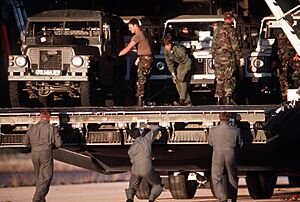
Helping New Countries Form
UN Peacekeepers have also helped oversee independence movements and the creation of new states. Starting in 1989, UNTAG in Namibia oversaw the withdrawal of South Africa and the election of a new government. In 1991, a ceasefire and a vote (referendum) were planned by Morocco for the region of Western Sahara. Disagreements stopped the vote, but the ceasefire continues to be watched by MINURSO. In East Timor, in 1999, a vote chose independence from Indonesia. Violence by groups against independence followed. UNTAET was set up to take control and manage the area until independence. After independence, an assistance mission, UNMISET, was established. Violence in 2006 led to the creation of UNMIT, which still monitors the situation.
See also
- List of United Nations peacekeeping missions
- History of the United Nations
- Timeline of United Nations peacekeeping missions
- International Day of United Nations Peacekeepers
- Attacks on humanitarian workers


